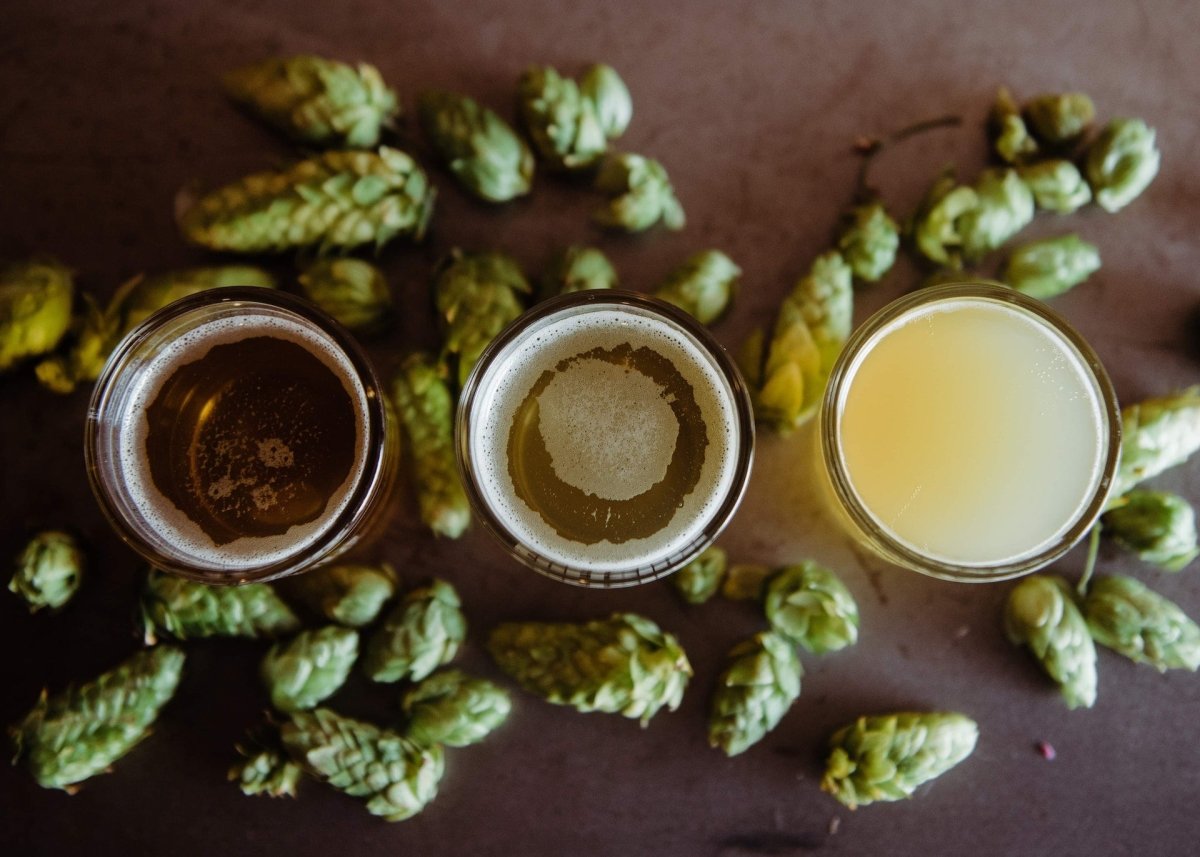-
Shop Beer
-
Shop Merchandise
-
Blog
-
Find Us
-
About
Your cart is empty
Looks like you haven't added anything to your cart yet

The Story of American IPA
As another Fourth of July comes and goes, we experience it like any other summer day. American Independence Day may not mean much to the average Brit, but it should mean something to craft beer lovers.
For several decades, the waves of American craft brewing have affected our windy, pebbly shores. No other beer style has a greater influence than the American IPA. July is a great time to celebrate this much-beloved hoppy ale.
The Legend of the IPA
As a preservative, hops were a mainstay in beer for centuries before the existence of pale malts. It was only natural that hoppy pale ale would emerge spontaneously. So, when and where did it all begin?
If you’ve had more than a few pints of hoppy beer, you’ve likely heard the myth of India Pale Ale. Often retold down the pub with some variation, the romanticised legend goes something like this:
“In the mid-1700s, the British Empire was sending ale to India. The journey was so long and rough, that beer would be sloshed around and completely spoiled when it reached its destination. Because of this, brewers upped the hopping dose and the alcohol to preserve the beers during their treacherous voyage. These extremely boozy, bitter beers quickly became favoured in India and Empire. Alas, the birth of the original IPA.”
This story isn’t exactly accurate. According to renowned beer historian Martyn Cornell, ales and dark porters were successfully exported to India long before IPA. And “pale ales for India” as they were called, were often lower in original gravity (thus, lower in alcohol) than milds, stouts, and porters—never let facts get in the way of a good story!
Additionally, common knowledge that George Hodgson’s Old Bow Brewery in East London “invented” the IPA is dubious at best, but we digress.
Pre-Prohibition Brewing in America
One or two decades ago, you’d be forgiven for thinking that American brewers only made flavourless pale pilsner. But that wasn’t always the case. It’s certainly not an accurate description today.
In the 19th and early 20th centuries, German brewing was gaining popularity in America. However, British brewing traditions were still going strong. Many breweries churned out a range of ales including IPAs. We don’t have a lot of information about recipes, but it’s most likely that these IPAs were very similar to their British counterparts.
Prohibition in 1918
A growing temperance movement fuelled by Protestantism saw the US Congress pass the Prohibition Amendment in 1918. Between a rise in crime from bootleggers and speakeasies, poisonings from moonshine, and economic decline, Americans quickly came to regret Prohibition.
Despite national trends for better overall health and lower absenteeism, the public voted to repeal Prohibition on 5 December 1933. Estimates count that over 200 distilleries and 1000 breweries shut down during Prohibition.
The sudden retraction of market competition accelerated the consolidation of US breweries. Insatiable corporations hunted and devoured local brewers to near extinction.
Ballantine IPA

Ballantine IPA has roots in America going back to 1840
Image source: Wikipedia
The only IPA that survived the rise and fall of the 18th Amendment was from Ballantine and Sons Brewing Company. Founded in 1840, the Ballantine IPA was hopped with Bullion and later Brewers Gold and Yakima Goldings until production ceased in 1996. Ballantine IPA held a —niche following that included writers Hunter S. Thompson, Ernest Hemingway, and John Steinbeck. IPA helped craft some of the greatest American Novels of the 20th century!
Despite going out somewhat with a whimper, Ballantine IPA did survive long enough to inspire the hoppy pales of today.
USDA Hop Breeding
The United States Department of Agriculture (USDA) began developing hop cultivars as far back as 1931. The program at Oregon State University aimed to breed American Cluster hops that were more resistant to downy mildew. There was no goal to increase flavour, aroma or bitterness.
A verticillium wilt epidemic in the 1950s led brewers to push for greater cultivar diversity with American hops. Many decades later, a crossbreed from British Fuggle and Russian Serebianka hops would be named “USDA 56013.”
In 1968, John Secal, a Yakima Valley farmer, was the first to grow 56013. Four years later, the experimental hop was named “Cascade.” In 1975, Anchor Brewing produced the first beer to feature Cascade hops, Liberty Ale. You can still find this beer available today.
The Legalisation of Homebrewing
Coinciding with the call for a greater selection of domestic hops was the growth of the Great American Homebrewer. Initially an illegal and underground hobby, President Jimmy Carter signed a bill legalising homebrewing in 1978. As a federal law, it would still be up to each state to legalise the niche hobby.
The following generations of American homebrewers would drive the new wave of “hoppy” and “craft” beer. One of the pillars of this movement was the development of hops like Cascade. The other was the ease of international travel.
The Uptick in International Travel
US airports began to mature during the Concorde era of the 1960s. However, it was in the 1980s that long-haul flights became a mainstream travel method. American cities were becoming cosmopolitan. The middle class was going international.
A popular destination was Europe. Beer enthusiasts and homebrewers were drinking tripels in Belgium, saisons in France, pilsners in Germany, and pale ales in the UK. Upon returning home, they wondered why they couldn’t find those beer categories locally—why not brew their own?
Pioneers of Hoppy Beer
The modern IPA story begins with several key players.
Anchor Brewing
Anchor Brewing is the oldest craft brewery still operating in America [note: it is sadly ceasing operations on July 31st 2023]. Its roots go back to 1896, but its purchase by Fred Maytag III in 1965 made it what it is today. Before the ahead-of-its-time Liberty Ale was in production, Anchor was already putting out timeless offerings like their Porter and Steam Lager.
New Albion Brewing Co.

New Ablion Brewing Company’s short existence has had a long-standing impact on craft beer
Image source: Wikipedia
Jack McAuliffe opened his 200L brewery in Sonoma, California in 1977. An optical engineer in Silicon Valley and a passionate homebrewer, McAullife managed to piece together a three-level brewhouse from converted Coca-Cola syrup drums and other bits.
Starting at such a small scale, New Albion Brewing appeared doomed to fail from the start. After being unable to make money for six years, the brewery closed its door permanently.
The brewery didn’t shut down because of its beers. In fact, New Albion hoppy ales would go on to inspire magic from others.
(There’s a happy ending to this tale. With the help of the Boston Beer Company (Sam Adams), the New Albion name was relaunched with Jack’s original recipes in 2012).
Sierra Nevada Brewing Co.
In 1979, homebrewers Ken Grossman and Paul Camusi set up Sierra Nevada Brewing Co. in Chico, California. Sierra Nevada Pale Ale (brewed with Cascade) was released in 1980. Perceived as “highly hopped”, the pale ale challenged drinkers' palates.
Grossman and Co. reached new hop heights with the winter seasonal Celebration IPA. Celebration is hopped with Cascade, Chinook, and Centennial in amounts few commercial brewers had dared to attempt. Amber in colour, it’s a hoppy, malty, classic.
Grant’s Brewery Pub
Not everything in this story happens in California! Born in Scotland, Bert Grant opened his brewpub in Yakima, Washington in 1982. It was the first brewpub in America since before Prohibition.
Besides resurrecting the brewpub model for small and medium breweries, Bert Grant has a long-standing legacy as a brewing pioneer. He is credited with building the first hop pelletising machine in the US.
Grant's Scottish Ale had reached national acclaim. The brewpub’s Imperial Stout and IPA (50 IBUs) also made waves in the craft beer community. Although even the scotch ale (40-45 IBUs) and impy stout (75-80 IBUs) were packed with US hops.
Grant’s Brewery persisted until 2004 but its effect on the industry is still felt today.
The Evolution of American IPA
Since its humble beginnings, American IPA has risen and fallen several times through many iterations and rebirths.
1990s
Many in American craft brewing look at the 90s with rose-tinted glasses. Research by Jeff Alworth of Beervana found that IPA wasn’t as ubiquitous as some remember. He found two brewery reference books in which IPA accounted for only 3/235 and 8/187 beers listed in each book.
During this time, small breweries and brewpubs were putting out classic IPAs that were more dark amber than pale. Following trailblazers like Liberty and Sierra Nevada, many of these IPAs featured relatively high amounts of both speciality malts and hops.
Most were around 6-7% ABV and assaulted the palate with sweet and bitter notes like a grapefruit negroni. Examples of nineties IPA include Swami’s IPA from Pizza Port and Lagunitas IPA.
Vinnie Cilurzo and Blind Pig Brewing Co.
It would take more brewers getting involved before IPA would go pale. While we can’t really point to just one brewer for the next evolution of IPA, that’s exactly what we’re doing. Enter one Vinnie Cilurzo. You may have heard of the co-owner of Russian River Brewing Co.
But first let’s head to Temecula, California where Vinnie’s first brewery launched Blind Pig IPA in 1994. Vinnie was so inspired by the IPA of the Empire that his early renditions involved ageing the beer on oak chips to simulate time spent in barrels on a ship!
Packing a punch at 92 IBUs, Blind Pig IPA would inspire many up-and-coming San Diego IPA merchants, including the original brew dogs, Stone Brewing Co.
2000s

Russian River occasionally brews the original Blind Pig IPA
Image source: Russian River Brewing
While the Blind Pig Brewery folded in 1999, Vinnie had moved on to bigger and better things at the Russian River Brewing Company in Santa Rosa, California. Here he would release Blind Pig IPA 2.0. Equally as important, he created the consensus original Double IPA, Pliny the Elder and a Triple IPA, Pliny the Younger.
These modern IPAs were ditching the speciality malt, using hop oil extract, and dextrose (simple sugar). The result was a clear, golden pale ale where hops like Chinook and Simcoe were at the forefront. A palate-cleansing bitterness masked ABVs ranging from 6-10% ABV.
At the same time, Stone Brewing was putting out its IPA, Arrogant Bastard and the uber-hopped Ruination. Other notable IPAs at this time included Bear Republic’s Racer 5 IPA, Firestone Walker Union Jack IPA, and Green Flash West Coast IPA.
Towards the end of the decade, speciality IPAs were gaining in popularity. Breweries were dabbling with Black IPAs, Red IPAs, White IPAs, and Belgian IPAs. (Now defined in the BJCP 2021 guidelines).
However, the 2010s were the era of the New England IPA. IPA had shifted from clear, clean, and bitter to hazy, juicy, and slightly sweet.
NEIPA is far too large and hotly debated—we’ll save that for another time!
Celebrate American Craft Brewing
Our cousins across the pond don’t always get everything right (overturning Roe v Wade anyone?). America didn’t invent the IPA, but they carried it closer to perfection.
We’re all about drinking more and also doing more the next day. American IPA is lovely but 7-9% ABV beer is dangerous. That’s why even our full-strength Lumber Jill IPA finishes at a sessionable 5.1% ABV. We also offer the hop-forward 2.8% ABV Shetland Pony Pale Ale which is packed with grapefruit, lychee, and gooseberry.
You join us in saluting American brewing pioneers when you crack into a hoppy IPA this summer. Cheers until next time!
- Choosing a selection results in a full page refresh.


